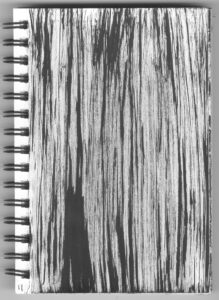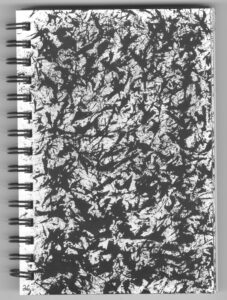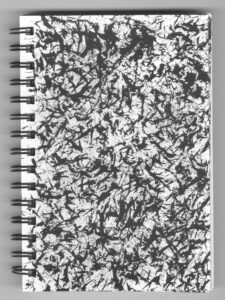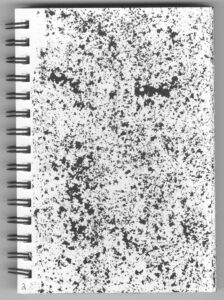Yesterday I made 42 new ink textures. I made them in a sketchbook that has 42 pages (I filled the front of all the pages). A 5.5 by 8 inch Strathmore Visual Journal sketchbook that had good thick 100 pound paper. I made textures last year and filled up the front and back pages of one of these sketchbooks so I aim to eventually fill the back side of the pages in this one too.
I had fun making these textures. It was a day when I was having a hard time getting anything creative done. I did a little bit of drawing and made a painted sketch card but didn’t have the ambition to get anything big started. Some days are like that. So I pulled out the empty sketchbook and decided to make ink textures.
I use these ink textures digitally. After I make them I scan them in as greyscale documents. After scanning I set them up so that I can use them both in Photoshop and Illustrator. Just scanning them really means that I can use them in Photoshop but to make them Illustrator ready I first have to turn them into Bitmapped files and then bring those files into Illustrator and auto trace them so they become vector files. I can usually do this fairly quickly as I use Actions (Macros) to automate as many of the steps as I can.
I started out making this batch of textures with stamps. Back in the 1990s I bought these stamps, the kind you press into a stamp pad to ink, that didn’t have an image on them but were just texture. One was a lot of little dots and the other was a denser grainy sort of texture. I also had two stamps of famous paintings. One was a Renoir and the other a Van Gogh.

Rather than use a stamp pad I took an old battered brush, dipped it in ink, and rubbed the brush all over the stamp. Then I pressed the stamp onto the paper and it left some ink texture behind. It takes about eight to ten stamps to fill the page but in reality I stamped the page many more times than that.
I was looking for different patterns in my in textures so depending on how much ink was on the stamp and how hard I pressed it would leave a different mark. So I took the time to make each page of textures distinct from the others. With the four different stamps I could make a lot of different textures.
Forty two pages of textures is a lot. So after making a bunch of them I got bored with the stamps and moved on to a big brush. I have an old and crappy bamboo brush that was perfect for this project. The bristles no longer form a point and are a couple of inches wide when the brush is dry. So I put a little bit of ink on my ink stone and mashed the brush into the ink. The result was a big wide brush with about twenty five tips to it.

I gently dragged the brush across the paper and it would make a whole bunch of parallel ink lines. Rough and uneven lines. Those are good for making texture. I even spun the brush around making circular spirals of texture. I had a good time working with that brush. Sometimes I’d drag it across and work with those jagged lines and sometimes I’d dab the brush on the paper and work with those small marks. It gave me a lot of options.
I also discovered a new tool for making good textures. A pot scrubber. Just last week I found a six pack of those flat green pot scrubbers that are used for doing dishes. They were in the pantry and had fallen down behind stuff. They caught my eye on that texture making day and I thought that maybe I could use them to make textures. And I could.
The scrubbers are around four by six inches and I cut off a piece about four by two inches. About a quarter to a third of the scrubber. It’s made of a stiff fibrous plastic that has a lot of air in it. I took my battered old brush and rubbed some ink onto the scrubber. It took a lot more ink to wet it than a solid stamp so I had to be careful with it and use a light touch or all the ink would come out of it at once and make a big black blob.
It turned out to be easy to work with a light touch. I could dab the scrubber and leave patterns of ink or I could draw it across the page and leave rough lines of ink. It turned out to be a very versatile tool for making ink patterns. I was able to do lots of pages with it.

It took a solid three or four hours of my Saturday to fill up the forty two pages with ink patterns. It was a pleasant afternoon though. I’m glad I was able to get something done. Some days when I want to be creative but don’t have it in me it’s good to do tasks like this. They’re not as creative as working on a drawing or painting but they are things that will help with drawings and paintings in the future. I’ve already incorporated the first book of textures that I made into a few digital prints. Textures make digital prints look a lot more interesting.
I could probably make digital textures fairly easily. I know how. It’s almost the same method as real ink textures. You pick a brush and make some digital marks with it. But I don’t find the digital textures nearly as interesting. It seems I have less control over them as I make them. I can get what I want easier with physical ink and paper.
In looking back at the book I think I like the textures made with the stamps best. The way they came out is pretty cool. I think I’m going to have to make more of them on the back side of these thick pages. But that’s for another day. Maybe even another day when the creative river isn’t flowing as swiftly as I want it to. We’ll see.
